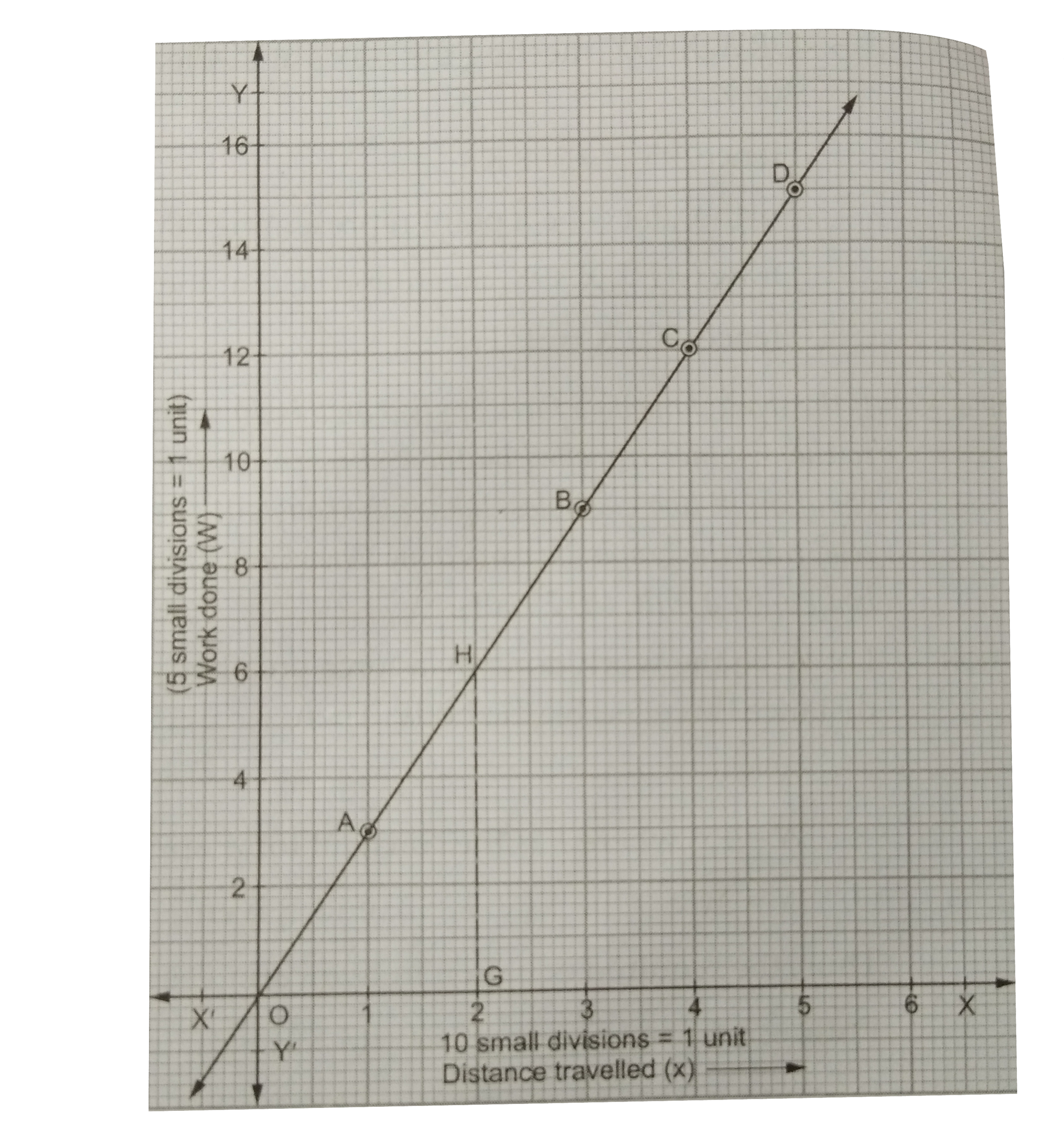If the work done by a body on application of a constant force is directly proportional to the distance travelled by the body, express this in the form of an equation in two variables and draw the graph of the same by taking the constant force as
Let W be the work done by a force on a body and let x be the distance travelled by the body. Then,
W∝x
⇒ W= Fx, where F is the constant force applied on the body
⇒W=3x[∵F=3units (given)].
Thus, the required equation in two variables is W = 3x . ... (A)
Putting x=1 in (A), we get W = (3×1)=3.
Putting x=3 in (A) , we get W=(3×3)=9.
Putting x= 4 in (A) , we get W=(3×4)=12.
Putting x = 5 in ( A) , we get W = (3×5)=15.
Thus, we have the following table.
x1345W391215
On a graph paper draw mutually perpendicular lines X' OX and YOY' as the x- axis respectively.
Along the x- axis, take 10 small divisions = 1 unit and along the y- axis , take 5 small divisions = 1 unit.
On this graph paper, plot the points A(1,3),B(3,9),C(4,12)andD(5,15). Join AB, BC and CD to obtain the graph line ABCD, shown below.

Produce the graph line ABCD in both the directions.
(i) Clearly, the graph line passes through the point O(0,0).
∴x=0⇒W=0.
Thus, when the body travels 0 distance , the work done is 0.
(ii) Take a point G on the x- axis such that x=2.
Draw GH⊥ x-axis, cutting ABCD at H(2,6).
∴x=0⇒W=0.
Thus, when the body travels 2 units, the work done is 6 units.
Topper's Solved these Questions
- LINEAR EQUATIONS IN TWO VARIABLESBOOK - RS AGGARWALCHAPTER - LINEAR EQUATIONS IN TWO VARIABLESEXERCISE - Exercise 4A
7 Videos
- LINEAR EQUATIONS IN TWO VARIABLESBOOK - RS AGGARWALCHAPTER - LINEAR EQUATIONS IN TWO VARIABLESEXERCISE - EXERCISE 4B
12 Videos
- INTRODUCTION TO EUCLID'S GEOMETRYBOOK - RS AGGARWALCHAPTER - INTRODUCTION TO EUCLID'S GEOMETRYEXERCISE - Multiple Choice Questions (Mcq)
27 Videos
- LINES AND ANGLESBOOK - RS AGGARWALCHAPTER - LINES AND ANGLESEXERCISE - Multiple Choice Questions (Mcq)
28 Videos
Similar Questions
The force exerted to pull a cart is directly proportional to the acceleration produced in the body. Express the statement as a linear equation of two variable and draw the graph of the same by taking the constant mass equal to 6 kg. Read from the graph the force required when the acceleration produced is
(i) 5m/s2 (ii) 6m/s2.
View SolutionThe work done by a body is the product of force and :
View Solution
Knowledge Check
If a constant force acts on a body initially at rest, the distance moved by the body in time t is proportional to
AtBt2Ct3Dt4The force of freely falling body is directly proportional to
Amass of bodyBacceleration of bodyCvelocity of bodyDboth (a) and (b)If a constant force acts on a body initially kept at rest, the distance moved by the body in time is proportional to
AtBt2Ct3Dt4
When the mass of a body is kept constant, its acceleration is directly proportional to the ______ acting on it.
View SolutionWork Done By A Constant Force
View SolutionDraw distance time graph of a body moving with constant acceleration.
View SolutionA rigid body is acted upon by a horizontal force which is inversely proportional to the distance covered 's'. The work done by this force will be proportional to
View SolutionA body is acted upon by a force which is inversely proportional to the distance covered. The work done will be proportional to
View Solution
